Wiz-42
By Jared B. McComb
Introduction
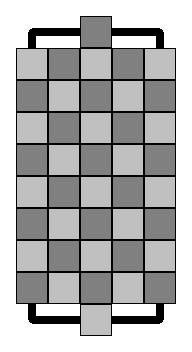
|
Wiz-42 is a game played on the board shown at left. The board is 8x5 with two additional squares, one on either end. The four thick black lines are not spaces; they will be explained below. It is a game for two players, White and Black, each with an army of sixteen pieces. |
Rules
The rules for this game are identical to those used in FIDE Chess except where noted otherwise.
Setup
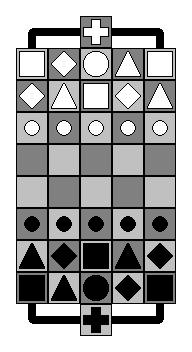
|
This is the opening setup. Each player has one king, one wizard,
three rooks, three knights, three bishops, and five pawns.
In this diagram, the kings are represented by crosses, the wizards by circles, the rooks by squares, the knights by triangles, the bishops by diamonds, and the pawns by spots. |
Pieces
King
The king moves as the king from FIDE Chess. In addition, the king may move between any cells connected by a heavy black line.
Rook
The rook moves as the rook from FIDE Chess. There is no castling, and it may not use the heavy black lines.
Knight
The Knight moves as the knight from FIDE Chess. It may not use the heavy black lines.
Bishop
The bishop moves as the bishop from FIDE Chess. It may not use the heavy black lines.
Pawn
The pawn moves as the pawn from FIDE Chess, except that it has no double first step, and there is no en passant capturing. Pawns may only promote to wizards, and do so upon reaching the second-to-last rank (the final rank that contains five squares).
Wizard
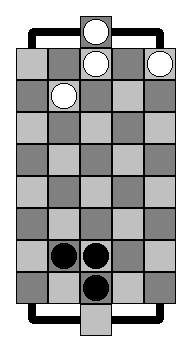
The wizard, which is the piece from which this game derives its name, may move like the king, including the heavy black line move. The wizard is allowed to move into a space occupied by any friendly piece; it then switches places with it. One of the consequences of this is that bishops are no longer colorbound. In addition, if two or more wizards are in a connected group (i.e. each one is orthogonally or diagonally adjacent to at least one more) then any of them they may make multiple wizard's moves in succession, where the number of moves equals or is less than the number of the wizards in the group; it may perform a switch or capture during any single move it makes, but it may not leap or visit the same square twice. This is an example of two groups of wizards. The Black team has a group of three connected wizards, and the White team has four (the one to the right is connected by a heavy black line).
Check, Checkmate, and Wizmate
Rules for check and mate are exactly like those for FIDE Chess - when pertaining to kings. It is also possible to win by leaving your opponent with no wizards, as long as they have had at least two during the course of the game (i.e. they have promoted at least one pawn). Then the rules of check also apply to the opponent's last wizard on the board. Checkmate delivered by the move of a wizard, or given to a final wizard, is called wizmate, but other than the name has no real difference from normal checkmate (except when playing the scoring variant; see below).
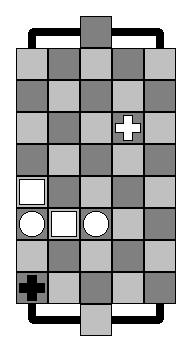
|
This is an example of a wizmate for White. It is White's turn to move, and he can execute wizmate in eight different ways. First, he can execute it in five ways by the wizard on the left; he can move it in any direction, switching if necessary. Second, he can execute wizmate in three ways using the wizard on the right; he may move it either west, southwest, or northwest, again switching if necessary. I leave it to the reader to figure out how Black is wizmated in each case. Note that wizmate here is delivered by a wizard's move, whether or not that wizard actually checks the king. |
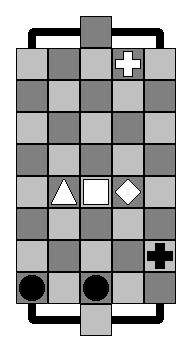
|
This is another example of wizmate for White, this time by capturing wizards. It is White's turn to move again; if he moves his rook to capture Black's right wizard, then Black is wizmated, as they cannot move their final wizard out of check. Note that it is not necessary to keep wizards out of check if you have two or more on the board. |
Strategy and Tactics
This game starts out a little crowded, and consequently the opening game is going to have a lot of capturing. The rooks will probably dominate most of the opening and middlegame if well guarded. Throughout the game, keep an eye on your opponent's pawns, as they can promote to wizards towards the middle and endgame, and a large number of wizards can mean an unstoppable force. However, it occasionally may be advisable to let your opponent promote exactly one pawn; then the two wizards he'll have still won't be very strong (long-range wise) and if you get one, the other must stay out of check. It is also advisable to try and keep your wizards near the pawns, especially near the endgame, so that they can quickly take advantage of their 'grouping power,' which can be nearly unblockable with large groups.
Variant
It is possible to play this game in the 'scoring' style; in this method of playing, a string of consecutive games is played, alternating sides. Each win counts as a point (draws as ½-point per player), wizmate counts as a double win (2 points), and game is to 5 points. If both players are tied at 4½ and there is another draw (so both players have five points), then the winner is the one who gets the next full win (checkmate or wizmate).
Credits
This game was invented by Jared B. McComb and was inspired mainly by Duchess (a 2, 3, 4, or 6 player CV played on a flower-shaped board that changes shape depending on the number of players). I devised the wizard's compound move out of a need for a more benign replacement for the strong pieces I didn't use out of Duchess (the queen, fortress, and duchess; these pieces were eliminated because they tend to overpower such a small board).
Written by Jared B. McComb. HTML Conversion by Peter Aronson.
Please send any comments to:
WWW page created: January 21st, 2002.